The At-Home Pregnancy Testing Market is estimated to be valued at USD 769.3 million in 2025 and is projected to reach USD 1169.3 million by 2035, registering a compound annual growth rate (CAGR) of 4.3% over the forecast period.
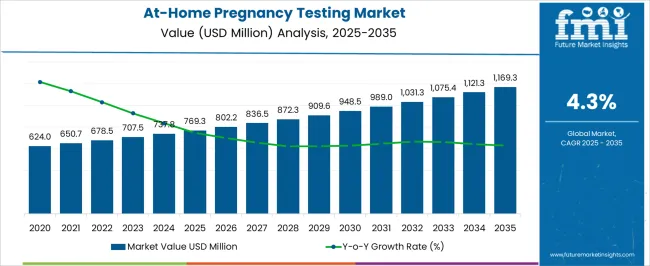
| Metric | Value |
|---|---|
| At-Home Pregnancy Testing Market Estimated Value in (2025 E) | USD 769.3 million |
| At-Home Pregnancy Testing Market Forecast Value in (2035 F) | USD 1169.3 million |
| Forecast CAGR (2025 to 2035) | 4.3% |
The At-Home Pregnancy Testing market is witnessing significant growth, driven by rising consumer preference for convenient, quick, and private pregnancy detection solutions. Increasing awareness of reproductive health and the importance of early pregnancy detection has fueled demand across both developed and emerging markets. Technological advancements in test accuracy, sensitivity, and ease of use have enhanced the reliability of at-home tests, supporting adoption by a broader consumer base.
The market is further influenced by the expansion of distribution channels, including retail and e-commerce platforms, which provide accessibility and convenience. Social acceptance of self-administered diagnostic tests and growing focus on women’s healthcare have strengthened market dynamics. Regulatory approvals and adherence to quality standards ensure consumer confidence in test accuracy and safety.
As lifestyles evolve and the demand for home-based healthcare solutions rises, the market is expected to sustain robust growth Continuous innovation in test formats, digital readouts, and integration with mobile health platforms is anticipated to create additional opportunities, making at-home pregnancy tests a critical segment within the broader reproductive health diagnostics market.
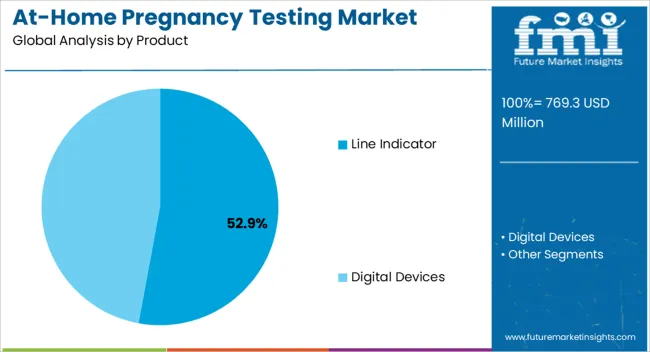
The line indicator product segment is projected to hold 52.9% of the market revenue in 2025, establishing it as the leading product type. Its market dominance is being driven by its ease of use, affordability, and widespread availability. Line indicator tests provide clear visual results and do not require specialized training or equipment, making them highly suitable for home use.
Reliability and consistent accuracy have reinforced consumer trust, while compact packaging and portability support convenience for diverse users. Marketing and educational initiatives have further promoted awareness of line indicator tests as a practical solution for early pregnancy detection. Technological improvements, including enhanced sensitivity to low hormone concentrations, have increased reliability and user confidence.
Distribution through retail and e-commerce platforms has strengthened accessibility, ensuring that consumers can obtain these products with minimal effort With rising awareness of reproductive health and ongoing innovations in test design, the line indicator product segment is expected to maintain its leading position, supported by consumer preference for simple, effective, and cost-efficient home testing solutions.
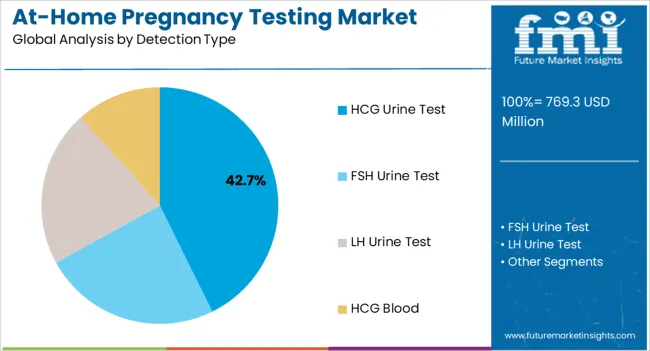
The HCG urine test detection type segment is anticipated to account for 42.7% of the market revenue in 2025, making it the leading detection category. Growth is driven by the ability of HCG urine tests to provide rapid, accurate, and non-invasive results in a home setting. These tests detect the presence of human chorionic gonadotropin, which is produced during early pregnancy, providing reliable confirmation without the need for laboratory visits.
The convenience of urine-based testing, combined with rising consumer preference for privacy and autonomy in healthcare, has reinforced adoption. Technological improvements have enhanced sensitivity, enabling earlier detection and reducing false negatives. Integration of digital readouts and mobile applications in some test formats is further enhancing user experience.
Awareness campaigns and healthcare education have increased acceptance of at-home urine testing as a trusted method As the demand for self-administered diagnostics continues to rise, the HCG urine test detection type is expected to maintain its market leadership, supported by accuracy, reliability, and ease of use.
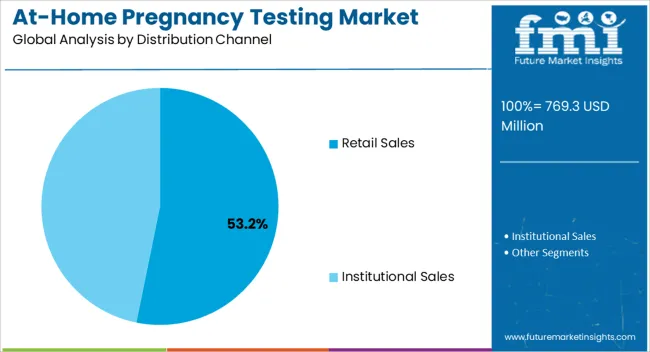
The retail sales distribution channel segment is projected to hold 53.2% of the market revenue in 2025, establishing it as the leading distribution route. Growth in this segment is being driven by the accessibility and convenience provided to consumers, allowing products to be purchased from pharmacies, supermarkets, and convenience stores. Retail channels enable immediate availability, supporting spontaneous and planned purchases, and often provide professional guidance for product selection and usage.
Marketing strategies and promotional activities within retail outlets further enhance visibility and awareness of at-home pregnancy tests. The growth of organized retail chains, particularly in urban regions, has strengthened distribution networks and facilitated widespread adoption.
Trust in established retail brands contributes to consumer confidence in product accuracy and quality As consumer preference for easy access to healthcare products continues to rise, the retail sales channel is expected to maintain its dominant position, supported by convenience, visibility, and reliable product availability across diverse regions and demographic segments.
From 2020 to 2025, the global at-home pregnancy testing market experienced a CAGR of 3.0%, reaching a market size of USD 769.3 million in 2025.
From 2020 to 2025, the global at-home pregnancy testing market industry witnessed steady growth due to the increased awareness and acceptance of at-home pregnancy testing.
At-home pregnancy test kits have gotten increasingly accurate and dependable over time, providing findings with a high degree of confidence. This improvement in performance has increased customer trust and increased the popularity of these tests.
The societal change towards more open conversations about reproductive health, particularly pregnancy and fertility, has contributed to the rise of at-home pregnancy test kits. As the stigma around these issues fades, women feel more at ease taking care of their reproductive health using these kits.
The legalization of over-the-counter sales of pregnancy test kits in certain countries has considerably aided industry expansion. This made it possible for women to acquire these tests without a prescription, resulting in greater adoption.
Future Forecast for At-home Pregnancy Testing Market Industry:
Looking ahead, the global at-home pregnancy testing market industry is expected to rise at a CAGR of 4.5% from 2025 to 2035. During the forecast period, the market size is expected to reach USD 1169.3 billion by 2035.
The at-home pregnancy testing market industry is expected to continue its growth trajectory from 2025 to 2035. Continued technological improvements are anticipated to increase the accuracy, sensitivity, and usability of at-home pregnancy test kits. This might include improvements in detecting methods, user interfaces, smartphone integration, and connection capabilities, all of which could boost demand for these goods.
With more women working and leading busy lifestyles, the simplicity and accessibility of at-home pregnancy test kits becomes even more enticing. The ability to confirm pregnancy swiftly and discreetly without the necessity for medical checkups can be a key element in driving market expansion.
| Country | The United States |
|---|---|
| Market Size (USD million) by End of Forecast Period (2035) | USD 1169.3 million |
| CAGR % 2025 to End of Forecast (2035) | 5.2% |
The at-home pregnancy testing market industry in the United States is expected to reach a market size of USD 1169.3 million by 2035, expanding at a CAGR of 5.2%. There is a high level of awareness and adoption of at-home pregnancy testing kits among women in United States.
The convenience, privacy, and ease of use offered by theses kits have contributed to their widespread acceptance.
At-home pregnancy testing kits are widely available in pharmacies, drugstores, supermarkets, and online stores. The easy accessibility and affordability of these kits make them a convenient choice for women seeking to confirm their pregnancy status.
| Country | The United Kingdom |
|---|---|
| Market Size (USD million) by End of Forecast Period (2035) | USD 56.7 million |
| CAGR % 2025 to End of Forecast (2035) | 4.9% |
The at-home pregnancy testing market industry in the United Kingdom is expected to reach a market share of USD 56.7 million, expanding at a CAGR of 4.9% during the forecast period due to growing demand for self-care.
The United Kingdom has witnessed an increasing trend of self-care and self-diagnosis. At-home pregnancy testing kits align with this trend, allowing women to manage their healthcare needs in the privacy of their homes.
| Country | China |
|---|---|
| Market Size (USD million) by End of Forecast Period (2035) | USD 118.6 million |
| CAGR % 2025 to End of Forecast (2035) | 6.0% |
The at-home pregnancy testing market industry in China is anticipated to reach a market size of USD 118.6 million, moving at a CAGR of 6.0% during the forecast period due to the expanding urban population.
Chinas urban population is growing rapidly, leading to increased demand for convenient and accessible healthcare solution. At-home pregnancy kits provide an easy and discreet method for women to determine their pregnancy status without the need for a clinic visit.
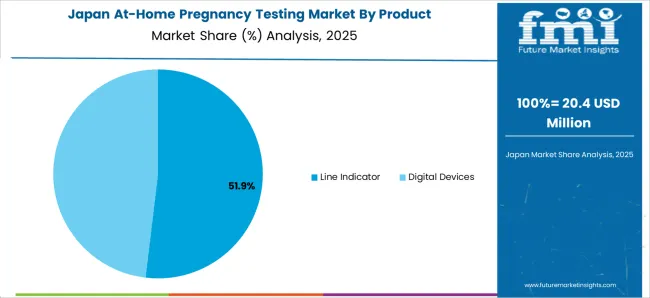
| Country | Japan |
|---|---|
| Market Size (USD million) by End of Forecast Period (2035) | USD 61.7 million |
| CAGR % 2025 to End of Forecast (2035) | 4.7% |
The at-home pregnancy testing market industry in Japan is estimated to reach a market size of USD 61.7 million by 2035, thriving at a CAGR of 4.7%. The increasing participation of women in the workforce in the country has led to higher demand for at-home pregnancy testing kits.
These kits enable women to quickly and discreetly confirm their pregnancy status, facilitating informed decisions about their careers and personal lives.
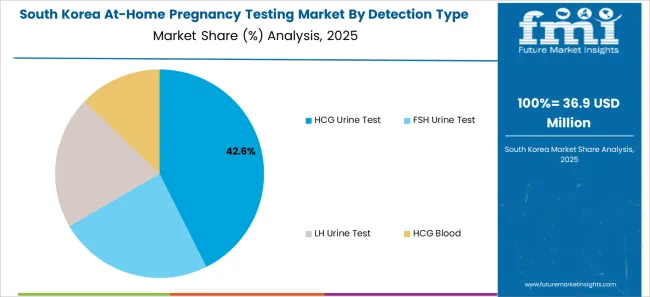
| Country | South Korea |
|---|---|
| Market Size (USD million) by End of Forecast Period (2035) | USD 34.0 million |
| CAGR % 2025 to End of Forecast (2035) | 5.2% |
The at-home pregnancy testing market industry in South Korea is expected to reach a market size of USD 34.0 million, expanding at a CAGR of 5.2% during the forecast period.
The rise in of e-commerce and online retail platforms in China has facilitated the availability and accessibility of at-home pregnancy testing kits. Online platforms offer a wide range of brands and options, making it convenient for consumers to purchase these kits from the comfort of their homes.
The line indicator devices is expected to dominate the at-home pregnancy testing market industry with a CAGR of 4.0% from 2025 to 2035. This segment captures a significant market share in 2025 due to its rapid testing procedures and detection
Many women prefer to detect pregnancy at the earliest possible stage, line indicators are designed to detect even low levels of hCG in Urine, enabling early pregnancy detection. Rising desire for early confirmation of pregnancy contributes to the demand for line indications in at-home pregnancy testing kits
hCG urine test are expected to dominate the at-home pregnancy testing market industry with a CAGR of 7.8% from 2025 to 2035. This segment captures a significant market share in 2025.
Urine tests are one of the most common methods used in pregnancy testing kits to detect the presence of human chronic gonadotrophin hormone in woman’s urine.
The retail sales in dominating the at home pregnancy testing market and is projected to grow at a CAGR of 4.8% over the forecast duration. The ease of availability of the testing kits without prescription in the retail pharmacies the adoption is high.
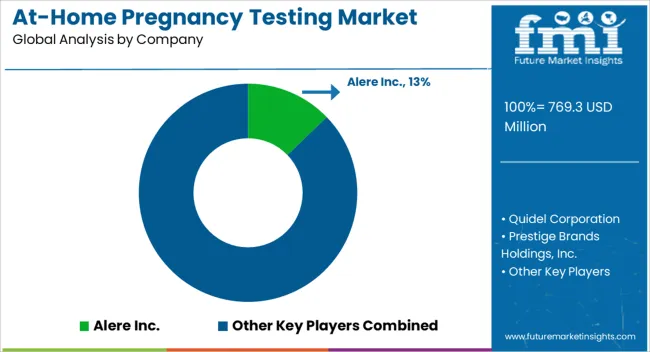
The at-home pregnancy testing sector is fiercely competitive, with many companies fighting for market dominance. To stay ahead of the competition in such a circumstance, essential players must employ smart techniques.
Key Strategies Used by the Participants
Product Development
To produce innovative goods that increase efficacy, dependability, and cost-effectiveness, businesses make significant investments in R&D. Product innovation enables companies to stand out from the competition while also meeting the shifting needs of their customers.
Strategic Alliances & Collaborations
Strategic alliances and partnerships with other businesses are regularly formed by major players in an industry to take advantage of each other's advantages and expand their market reach. Through such arrangements, businesses may also obtain access to new technologies and markets.
Expansion into Emerging Markets
The market for at-home pregnancy testing is rising quickly in developing nations like China and India. To boost their presence in these regions, major companies are expanding their distribution networks and building regional manufacturing sites.
Acquisitions and mergers
Key companies in the at-home pregnancy testing market routinely employ mergers and acquisitions to strengthen their market positions, broaden their product offerings, and enter new markets.
Key Developments in the At-home Pregnancy Testing Market:
The global at-home pregnancy testing market is estimated to be valued at USD 769.3 million in 2025.
The market size for the at-home pregnancy testing market is projected to reach USD 1,169.3 million by 2035.
The at-home pregnancy testing market is expected to grow at a 4.3% CAGR between 2025 and 2035.
The key product types in at-home pregnancy testing market are line indicator, _cassettes, _midstreams, _strips, _dip cards, digital devices, _branded test kits and _private label test kits.
In terms of detection type, hcg urine test segment to command 42.7% share in the at-home pregnancy testing market in 2025.






Full Research Suite comprises of:
Market outlook & trends analysis
Interviews & case studies
Strategic recommendations
Vendor profiles & capabilities analysis
5-year forecasts
8 regions and 60+ country-level data splits
Market segment data splits
12 months of continuous data updates
DELIVERED AS:
PDF EXCEL ONLINE
At-Home Testing Market Analysis - Growth, Demand & Forecast 2025 to 2035
At-Home Cancer Testing Market - Growth & Forecast 2025 to 2035
At-home Molecular Testing Market Size and Share Forecast Outlook 2025 to 2035
At-Home Micronutrient Testing Industry Share, Size, and Forecast 2025 to 2035
Global Advanced At-home Biomarker Testing Market Analysis – Size, Share & Forecast 2024-2034
Pregnancy Care Products Market Analysis - Size, Share, and Forecast Outlook 2025 to 2035
Pregnancy Snacks Market Analysis by Product Type, Nutritional Content, Distribution Channel, Packaging Format and Stage of Pregnancy Flavors Through 2035
Pre-Pregnancy Genetic Testing Market Size and Share Forecast Outlook 2025 to 2035
Wearable Pregnancy Devices Market Trends and Forecast 2025 to 2035
Fertility Pregnancy Rapid Test Kits Market Analysis - Size, Share, and Forecast 2025 to 2035
Veterinary Pregnancy Test Kit Market Forecast and Outlook 2025 to 2035
United States of America Digital Pregnancy Test Kits Market Size and Share Forecast Outlook 2025 to 2035
Testing, Inspection & Certification Market Growth – Trends & Forecast 2025 to 2035
5G Testing Market Size and Share Forecast Outlook 2025 to 2035
AB Testing Software Market Size and Share Forecast Outlook 2025 to 2035
5G Testing Equipment Market Analysis - Size, Growth, and Forecast 2025 to 2035
Eye Testing Equipment Market Size and Share Forecast Outlook 2025 to 2035
HSV Testing Market Size and Share Forecast Outlook 2025 to 2035
IoT Testing Equipment Market Size and Share Forecast Outlook 2025 to 2035
HPV Testing and Pap Test Market Size and Share Forecast Outlook 2025 to 2035

Thank you!
You will receive an email from our Business Development Manager. Please be sure to check your SPAM/JUNK folder too.
Chat With
MaRIA